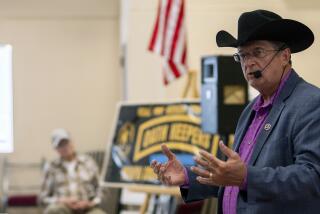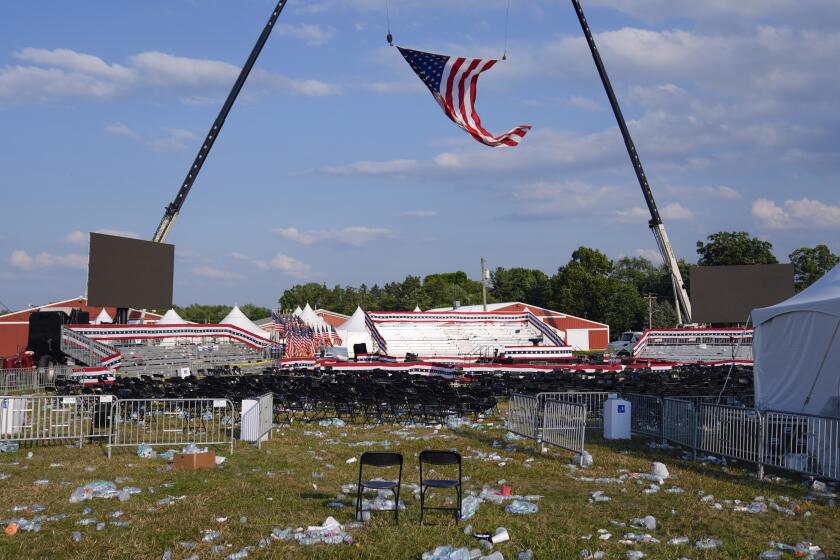Naval Station Gets 1st Black Captain : Military: Isaiah John Jones becomes commander of the sprawling Long Beach base. “I’m not a role model, I represent a possibility,” he tells sailors.
Navy Capt. Isaiah John Jones was walking on the Coronado Island Amphibious Base recently when a carload of young black sailors roared past him. The driver, catching a glimpse of the four gold bars gleaming on Jones’ shoulder, pulled a quick U-turn, jumped out of the car and walked up to the startled officer.
“I’d like to shake your hand,” Jones recalled the young man saying. “Why’s that?” Jones asked, giving the sailor his hand.
“I’ve never seen a black captain before,” he replied.
Jones, 52, is one of only 43 blacks among the Navy’s 2,000 captains. And in a morning ceremony last week, as sailors dressed in their summer uniforms stood in stiff white rows, Jones was welcomed as the first black commander in the 50-year history of the Long Beach Naval Station.
As he put it, the young, wide-eyed sailor who started his Navy career in Long Beach 32 years ago had come full circle.
For the next two years, Jones will, in effect, become mayor of a naval community of 14,500 enlisted men and officers, 1,000 civilians, 28 ships and the vast 2,100-unit station housing complex.
In his brief speech Tuesday, Jones said he would never have dreamed that he would be standing on a podium, addressing the ranks of sailors as the naval station’s commanding officer.
“To those who say that minorities cannot achieve this, who say there is absolutely no chance for a minority to make it in the military, I say . . . look around you,” he said.
Still, Jones, an easygoing man who speaks with an Alabama drawl, is reluctant to draw attention to himself.
“I’m not a role model, I represent a possibility,” he said. “I think young black sailors can look at me and say, ‘Hey, if this guy can make it, then I can make it.’ ”
Jones said he never intended to make the Navy his career. Born and raised in Birmingham, Ala., he graduated from high school and spent two years studying pre-engineering, mathematics and physics at Daniel Payne College. It was 1960, Jones was 19 years old, armed with a degree and filled with wanderlust when he walked into the Navy recruitment office and signed up for four years.
After a year of Navy schooling, he was sent to Long Beach, a station that, at first sight, terrified him.
“At that time, Long Beach was the home port of the Pacific fleet and there were 120 ships and two major commands here,” Jones recalled. “You had various squadrons and groups. It was really a metropolis. I was overwhelmed not only by the tempo of operations but also by the number of people here. It was almost like a boom town.”
Jones soon got his wish to see the other side of the world. He jokes that if he had to pay for all the trips he’s taken, the bill would be about $3 million.
He has served as chief engineer on battleships, including the Missouri, on submarines, and an aircraft carrier. He ran a liquid oxygen plant on a fuel farm in Alaska.
In 1990, he came back to Long Beach as the assistant chief of staff for ships maintenance, a job in which he was responsible for 38 ships and a multimillion-dollar budget.
Sometime during the years that passed, he forgot that he had planned to leave the Navy after four years.
“I had such a terrific time,” he said. “I advanced rapidly in the ranks. Everything I asked for the Navy gave to me. . . . It’s almost like having a father who likes you very much. You ask for anything and he gives it to you.”
Jones said that if there was racism in the Navy, he never knew it.
“It always seemed like people were willing to help me,” he said. “Senior people seemed willing to kind of nurture me along. At times, I was the only black on ship; it just didn’t seem to make a difference. Hey, you’re just another officer.”
In the time it has taken him to earn his four gold bars, he has also earned several awards for what he modestly calls “supposedly” meritorious service as an exceptional officer.
Capt. Andrew Fahy, who has worked as Jones’ commander in the past, called the new commander one of the “finest naval officers” he has worked with in his 27-year career.
“He never ceases to amaze me with the depth and breadth of his knowledge of engineering,” Fahy said. “He’s good.”
Even when he is off duty, Jones still can’t seem to tear himself away from engines. As a “middle-aged hot-rodder” he has built bigger, faster, stronger engines for his Corvette and BMW.
Jones now has one of his most difficult assignments, preparing a once-booming naval station for eventual closure. As a result of budget cutbacks, the station is scheduled to be shut down in 1996.
“The entire armed forces are downsizing because the threat as we knew it no longer exists, so we have to reshape accordingly,” he said. “It’s just like having a big house when all the children are gone.
“We are getting leaner and, of course, there are going to be some people that are going to be impacted. Some who hoped to be here for 10, 15 years. To them I say, ‘Don’t be dismayed, your dream isn’t gone. . . . We just have to adapt.’ ”
At its peak, during the mid-’60s, 140 ships were home-ported at the Long Beach station, and 40,000 men were assigned to the base. The numbers have steadily dwindled since then. Today, fewer than 30 ships and 15,000 officers and men make the station their home. The base was closed once during the 1950s, reopened during the Korean War, closed again in 1974 and reopened in 1979. “So, we are not new at this, we know what we are doing,” Jones said.
The captain emphasized that no matter what is to come, for now the station is going to continue its primary mission of supporting the fleet.
“We are going to keep this base as ready as possible to do its primary mission,” he said. “We are not going to stop any services. We are not going to cut the lights out and walk out. We’ve got work to do.”
More to Read
Sign up for Essential California
The most important California stories and recommendations in your inbox every morning.
You may occasionally receive promotional content from the Los Angeles Times.










